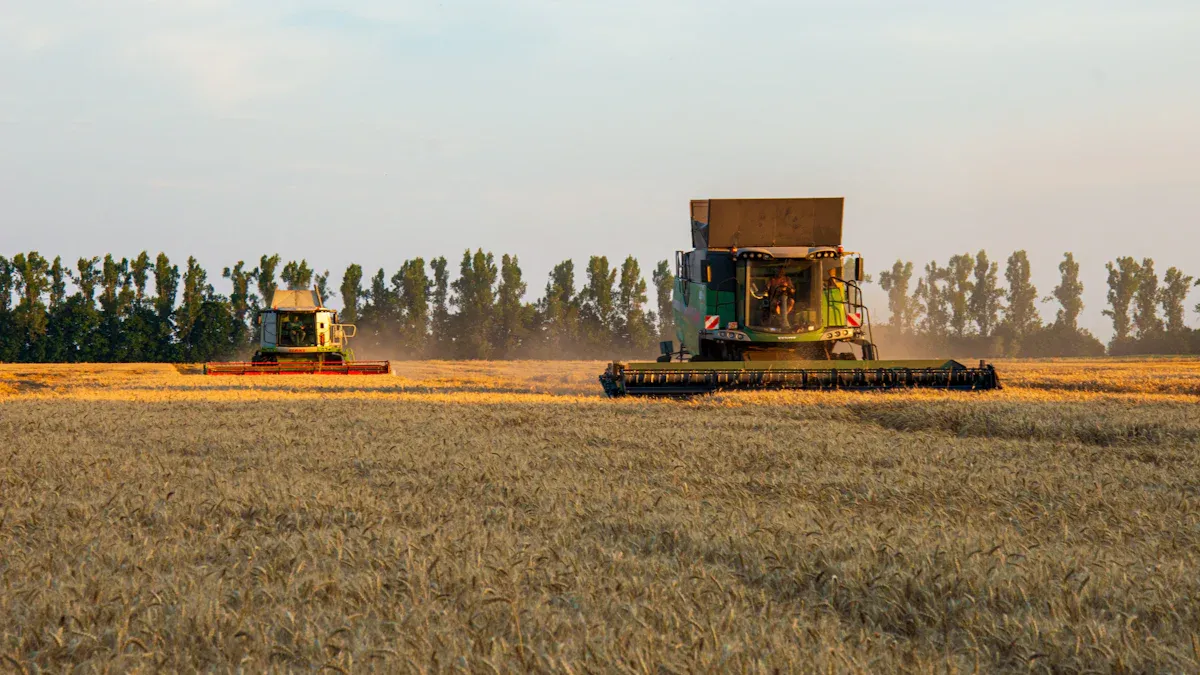
You face demanding conditions in agricultural fields. Protection design keeps your autonomous robot operating reliably under sun, rain, and dust. With robust design, you safeguard lithium battery packs from temperature swings. Every design choice impacts the durability and safety of your agricultural robot in the field.
Key Takeaways
Choose IP67-rated enclosures to protect your agricultural robots from water and dust. This ensures reliable operation in harsh weather conditions.
Implement thermal management systems, such as insulation and cooling, to maintain optimal battery performance. This prevents overheating and extends battery life.
Conduct regular inspections and maintenance on bolted joints and battery packs. This proactive approach prevents unexpected failures and costly downtime.
Part 1: Protection Design for Agricultural Robots

1.1 Sun, Rain, and Dust Barriers
You operate agricultural robots in fields where sun, rain, and dust challenge every component. You need protection that stands up to these elements. High ip67 enclosures shield sensitive electronics and lithium battery packs from water and dust. These enclosures prevent moisture and fine particles from entering, which extends the life of your robot.
You should select ruggedized enclosures with powder coatings. Powder coatings resist corrosion and UV damage, which is critical for outdoor robot docking stations exposed to sunlight and rain. UV rays degrade plastics and paints, so you must use UV-resistant materials for all external surfaces.
For dust protection, dust-proof covers and sealed cable glands keep out fine particles. You can use ip67 robot charging station designs to ensure safe charging in wet or dusty conditions. These stations protect connectors and battery terminals from corrosion and short circuits.
Tip: Always verify that your enclosures meet ip67 or higher standards. This ensures your agricultural robots withstand heavy rain, mud, and dust storms.
1.2 Wide Temperature and Thermal Management
Agricultural robots face temperature extremes, from freezing nights to scorching afternoons. You must design for both high and low temperature operation. Lithium battery packs require special attention because temperature swings affect their performance and safety.
You can use thermal insulation inside enclosures to buffer against rapid temperature changes. Active thermal management, such as air cooling for motors and battery packs, helps maintain optimal operating temperatures. For example, you can install fans or heat sinks to dissipate heat during peak operation.
Thermal runaway is a risk for lithium battery packs. You should integrate temperature sensors and thermal cutoffs to prevent overheating. These sensors monitor battery temperature and trigger shutdowns if limits are exceeded.
You must also consider the impact of UV and weather on thermal performance. UV-resistant coatings reduce heat absorption, while weather-sealed enclosures prevent water ingress that could cause short circuits or thermal stress.
Note: Always test your thermal management systems under real field conditions. Simulated lab tests may not capture the full range of temperature and weather challenges.
1.3 Material and Housing Choices
Material selection determines the durability and protection level of your agricultural robots. You should choose materials that resist UV, corrosion, and impact. Stainless steel and UV-stabilized polymers offer strong protection against weather and sun.
Bolted joints require careful design to withstand vibration and thermal expansion. You can follow these best practices:
Use synchronous tightening with high-precision equipment to ensure even preload.
Regularly monitor preload in bolted connections to prevent loosening.
Design joints for dynamic loads, accounting for vibration and impacts.
Commrrrrrrrrrrron failure modes for bolted joints include:
Fatigue fracture from alternating loads.
Shear or yield failure due to insufficient preload.
Vibration-induced loosening during operation.
You should use ip67 enclosures for all critical components, including lithium battery packs and control electronics. This level of protection ensures your robot operates reliably in all weather conditions.
For charging, ip67 robot charging station designs keep connectors dry and dust-free. These stations support autonomous operation by allowing robots to recharge in the field without manual intervention.
Material Type | UV Resistance | Corrosion Resistance | Impact Resistance | Typical Use Case |
|---|---|---|---|---|
Stainless Steel | High | High | High | Enclosures, frames |
UV-Stabilized Polymer | High | Medium | Medium | External covers, sensor housings |
Aluminum Alloy | Medium | Medium | High | Structural supports, heat sinks |
You must protect lithium battery packs not only from weather and dust but also from temperature and vibration. This ensures long-term durability and safety for your agricultural robots.
Part 2: Reliability Verification and Maintenance
2.1 Reliability Testing Methods
You must verify the reliability of every robot before deployment in agricultural fields. You need to test for temperature reliability, waterproofing, and dust protection. These tests ensure your robot performs under harsh weather conditions and meets industry standards.
You should conduct temperature cycling tests. These tests expose your robot to repeated heating and cooling cycles, simulating real field conditions. You can identify failures in lithium battery packs, electronic components, and structural joints. Temperature reliability testing helps you prevent thermal runaway and battery degradation.
Waterproof and dustproof tests confirm that your robot meets IP67 or higher standards. You immerse enclosures in water and expose them to fine dust. You check for leaks and contamination. These tests protect lithium battery packs and control electronics from moisture and dust.
You must comply with international standards such as IEC 60529 for ingress protection and ISO 16750 for environmental testing. These standards provide benchmarks for reliability and safety. You should document all test results and use them to improve future robot designs.
Test Type | Purpose | Standard Reference | Typical Failure Mode |
|---|---|---|---|
Temperature Cycling | Temperature reliability | IEC 60068-2-14 | Battery degradation |
Waterproof/Dustproof | Weather conditions protection | IEC 60529 | Short circuit, corrosion |
Vibration/Shock | Structural reliability | ISO 16750-3 | Bolted joint loosening |
Tip: You can request custom reliability testing for unique agricultural scenarios. Contact us for consultation to tailor your robot’s battery testing program.
2.2 Environmental Monitoring Systems
You need real-time monitoring to maintain reliability in autonomous agricultural robots. You should install perception systems and sensors to track temperature, humidity, and dust levels inside enclosures. These systems alert you to abnormal weather conditions and internal faults.
You can use temperature sensors to monitor lithium battery packs. If the temperature exceeds safe limits, the robot’s Battery Management System (BMS) triggers a shutdown or cooling response. This protects against thermal runaway and extends battery life.
You should integrate humidity sensors to detect water ingress. Early detection prevents corrosion and electrical failures. Dust sensors help you monitor air quality inside the robot, ensuring that filters and seals remain effective.
Functional safety depends on reliable sensor data. You must calibrate sensors regularly and validate their accuracy. You can use data logs to analyze trends and predict maintenance needs.
Note: Environmental monitoring systems support predictive maintenance. You can schedule service before failures occur, reducing downtime and improving reliability.
2.3 Installation and Maintenance Best Practices
You must follow strict installation and maintenance routines to ensure long-term reliability of agricultural robots. You should inspect bolted joints for preload loss and vibration damage. Use torque wrenches to achieve precise tightening and prevent joint failure.
You need to check lithium battery packs for physical damage, swelling, or corrosion. Replace damaged packs immediately to avoid safety risks. Clean connectors and terminals to maintain efficient charging and prevent short circuits.
Protective housings require regular inspection. Look for cracks, seal degradation, and UV damage. Replace worn seals and apply fresh powder coatings as needed. You should verify that all enclosures remain watertight and dustproof after each maintenance cycle.
Maintenance Task | Frequency | Key Checkpoints | Impact on Reliability |
|---|---|---|---|
Bolted Joint Inspection | Monthly | Preload, vibration, corrosion | Prevents structural failure |
Battery Pack Check | Quarterly | Swelling, corrosion, charge rate | Ensures temperature reliability and safety |
Housing Seal Replacement | Annually | Cracks, UV damage, water ingress | Maintains weather conditions protection |
You should train your maintenance team on best practices for autonomous robot care. Use standardized checklists and document all service actions. This approach improves reliability and extends the lifespan of your agricultural robots.
Alert: Neglecting maintenance routines can lead to unexpected failures and costly downtime. Schedule regular inspections to protect your investment.
You secure long-term durability and lithium battery safety by combining robust protection design, thorough reliability testing, and proactive maintenance. These strategies deliver strong outdoor performance for your agricultural robots. For tailored solutions and expert consultation, reach out to our team and advance your reliability standards.
FAQ
What makes lithium battery packs reliable in outdoor environments?
You benefit from IP67-rated enclosures and advanced BMS (Battery Management System) that protect lithium battery packs from moisture, dust, and temperature swings in outdoor environments.
How do you maintain your autonomous robot fleet during extreme environmental fluctuations?
You schedule regular inspections for bolted joints, battery packs, and protective housings. Large Power offers custom battery consultation for maintenance solutions tailored to your autonomous robot fleet.
Which environmental factors most affect lithium battery pack performance?
You face challenges from temperature, humidity, and dust. These factors impact battery safety and lifespan in any agricultural environment. Monitoring systems help you detect issues early.




